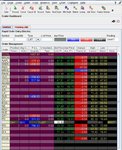LevII said:
Grey1, a potentially provocative question if I may.
Is this not dangerously close to being a martingale strategy? Should not the trader be sizing his position according to his account size, his risk tolerance in relation to it, the potential reward (at the MPD band or VWAP) and the volatility of the stock? Should he not be doing this exercise without considering his desire to make up losses? I do appreciate his set objective is to win every day.
Sorry if I have misunderstood.
My thanks also for another valuable thread.
LII
LEVII
Position sizing will come from your capital ( see example below ) how ever we need to have MPD band to tell us how to move from one stock to another . Therefore we use MPD bands as a means of measuring the risk element in STOCK SELECTION than position sizing .
Example
stock 1 reward 20c exposure needed 3000
stock 2 reward 80 c exposure needed 750
stock 2 seems to be a better candidate but , are we going to take 750 as our next trade ? Then read the next part..
POSITION SIZING
lets say your capital is $100 000
lets say we use 1% rule ( I will discuss the study of ruin in detail in future )
so stop loss would be $100 000 * 1 /100 = $1000
so we have $1000 in our hand to go shopping . Every stock has a price tag defined by their volatility
Stock A ATR 30 C i can afford to buy 3333 of this stock ( $1000 divided by 30 c)
Stock B ATR 50 C i can afford to buy 2000 of this stock
stock C ATR 120 C I can afford to buy 833 of this stock
next we look at the possible reward from MPD
Stock A MPD possibe reward 10 C
Stock B MPD possible reward 30 C
Stock C MPD possible reward 80c
remember we were down $600.
in above example stock C seems to be the correct stock ( 833 * 80= $644 which would recover my $600 loss plus $44 profit ) .. Hence we use MPD band as a confirmation for correct choice of stock
I think i have answered your question now.
Just one more explanation ... if you adjust your postion sizing according to ATR ( volatility ) then there is absoloutly no difference if a stock is HOT ( dangerous to play ) or cold . because you are taming the stock by reducing its postion size accoriding to its volatilty . There for for those who have read this thread and fully understood it it is safe to play any stock as long as you fully implement the simple and elementary position sizing technique i discussed
All above can be programmed into Trade station and you don't have to be bothered with any calculation intra day once you have coded it.. You must become as mechanical as possible.
Grey1



